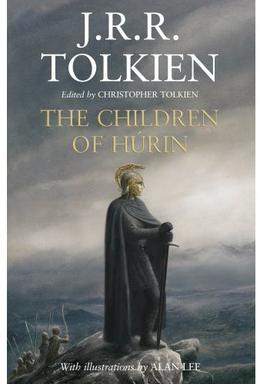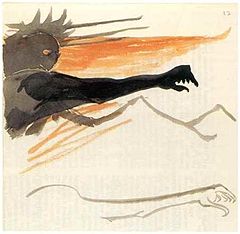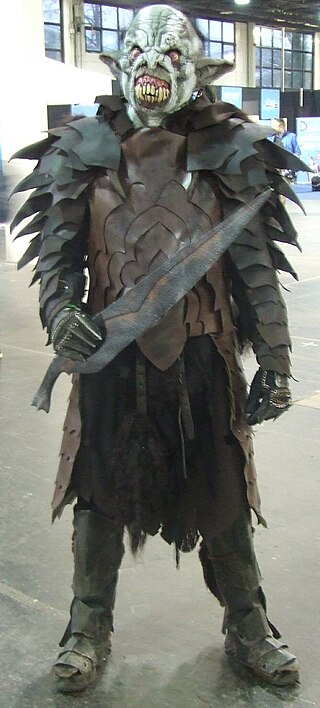The Rings of Power are magical artefacts in J. R. R. Tolkien's legendarium, most prominently in his high fantasy novel The Lord of the Rings. The One Ring first appeared as a plot device, a magic ring in Tolkien's children's fantasy novel, The Hobbit; Tolkien later gave it a backstory and much greater power. He added nineteen other Great Rings, also conferring powers such as invisibility, that it could control, including the Three Rings of the Elves, Seven Rings for the Dwarves, and Nine for Men. He stated that there were in addition many lesser rings with minor powers. A key story element in The Lord of the Rings is the addictive power of the One Ring, made secretly by the Dark Lord Sauron; the Nine Rings enslave their bearers as the Nazgûl (Ringwraiths), Sauron's most deadly servants.
A Balrog is a powerful demonic monster in J. R. R. Tolkien's Middle-earth. One first appeared in print in his high-fantasy novel The Lord of the Rings, where the Fellowship of the Ring encounter a Balrog known as Durin's Bane in the Mines of Moria. Balrogs appear also in Tolkien's The Silmarillion and his legendarium. Balrogs are tall and menacing beings who can shroud themselves in fire, darkness, and shadow. They are armed with fiery whips "of many thongs", and occasionally use long swords.

Unfinished Tales of Númenor and Middle-earth is a collection of stories and essays by J. R. R. Tolkien that were never completed during his lifetime, but were edited by his son Christopher Tolkien and published in 1980. Many of the tales within are retold in The Silmarillion, albeit in modified forms; the work also contains a summary of the events of The Lord of the Rings told from a less personal perspective.

Morgoth's Ring (1993) is the tenth volume of Christopher Tolkien's 12-volume series The History of Middle-earth in which he analyses the unpublished manuscripts of his father J. R. R. Tolkien.
Húrin is a fictional character in the Middle-earth legendarium of J. R. R. Tolkien. He is introduced in The Silmarillion as a hero of Men during the First Age, said to be the greatest warrior of both the Edain and all Men in Middle-earth. His actions, however, bring catastrophe and ruin to his family and to the people of Beleriand.

A fantasy trope is a specific type of literary trope that occurs in fantasy fiction. Worldbuilding, plot, and characterization have many common conventions, many of them having ultimately originated in myth and folklore. J. R. R. Tolkien's legendarium for example, was inspired from a variety of different sources including Germanic, Finnish, Greek, Celtic and Slavic myths. Literary fantasy works operate using these tropes, while others use them in a revisionist manner, making the tropes over for various reasons such as for comic effect, and to create something fresh.

The Children of Húrin is an epic fantasy novel which forms the completion of a tale by J. R. R. Tolkien. He wrote the original version of the story in the late 1910s, revising it several times later, but did not complete it before his death in 1973. His son, Christopher Tolkien, edited the manuscripts to form a consistent narrative, and published it in 2007 as an independent work. The book is illustrated by Alan Lee. The story is one of three "great tales" set in the First Age of Tolkien's Middle-earth, the other two being Beren and Lúthien and The Fall of Gondolin.
A Dark Lord is a powerful, villainous stock character that appears in the fantasy genre.
The Ainur (singular: Ainu) are the immortal spirits existing before the Creation in J. R. R. Tolkien's fictional universe. These were the first beings made of the thought of Eru Ilúvatar. They were able to sing such beautiful music that the world was created from it.
Númenor, also called Elenna-nórë or Westernesse, is a fictional place in J. R. R. Tolkien's writings. It was the kingdom occupying a large island to the west of Middle-earth, the main setting of Tolkien's writings, and was the greatest civilization of Men. However, after centuries of prosperity many of the inhabitants ceased to worship the One God, Eru Ilúvatar, and rebelled against the Valar, resulting in the destruction of the island and the death of most of its people. Tolkien intended Númenor to allude to the legendary Atlantis. Commentators have noted that the destruction of Númenor echoes the Biblical stories of the fall of man and the destruction of Sodom and Gomorrah, and John Milton's Paradise Lost.
The Maiar are a fictional class of beings from J. R. R. Tolkien's high fantasy legendarium. Supernatural and angelic, they are "lesser Ainur" who entered the cosmos of Eä in the beginning of time. The name Maiar is in the Quenya tongue from the Elvish root maya- "excellent, admirable".
Morgoth Bauglir is a character, one of the godlike Valar, from Tolkien's legendarium. He is the primary antagonist of The Silmarillion, The Children of Húrin, Beren and Lúthien, and The Fall of Gondolin.
An orc, in J. R. R. Tolkien's Middle-earth fantasy fiction, is a race of humanoid monsters, which he also calls "goblin".

Sauron is the title character and the primary antagonist, through the forging of the One Ring, of J. R. R. Tolkien's The Lord of the Rings, where he rules the land of Mordor and has the ambition of ruling the whole of Middle-earth. In the same work, he is identified as the "Necromancer" of Tolkien's earlier novel The Hobbit. The Silmarillion describes him as the chief lieutenant of the first Dark Lord, Morgoth. Tolkien noted that the Ainur, the "angelic" powers of his constructed myth, "were capable of many degrees of error and failing", but by far the worst was "the absolute Satanic rebellion and evil of Morgoth and his satellite Sauron". Sauron appears most often as "the Eye", as if disembodied.
Character pairing in The Lord of the Rings is a literary device used by J. R. R. Tolkien, a Roman Catholic, to express some of the moral complexity of his major characters in his heroic romance, The Lord of the Rings. Commentators have noted that the format of a fantasy does not lend itself to subtlety of characterisation, but that pairing allows inner tensions to be expressed as linked opposites, including, in a psychoanalytic interpretation, those of Jungian archetypes.
Tolkien's monsters are the evil beings, such as Orcs, Trolls, and giant spiders, who oppose and sometimes fight the protagonists in J. R. R. Tolkien's Middle-earth legendarium. Tolkien was an expert on Old English, especially Beowulf, and several of his monsters share aspects of the Beowulf monsters; his Trolls have been likened to Grendel, the Orcs' name harks back to the poem's orcneas, and the dragon Smaug has multiple attributes of the Beowulf dragon. The European medieval tradition of monsters makes them either humanoid but distorted, or like wild beasts, but very large and malevolent; Tolkien follows both traditions, with monsters like Orcs of the first kind and Wargs of the second. Some scholars add Tolkien's immensely powerful Dark Lords Morgoth and Sauron to the list, as monstrous enemies in spirit as well as in body. Scholars have noted that the monsters' evil nature reflects Tolkien's Roman Catholicism, a religion which has a clear conception of good and evil.

Tolkien's Art: 'A Mythology for England' is a 1979 book of Tolkien scholarship by Jane Chance, writing then as Jane Chance Nitzsche. The book looks in turn at Tolkien's essays "On Fairy-Stories" and "Beowulf: The Monsters and the Critics"; The Hobbit; the fairy-stories "Leaf by Niggle" and "Smith of Wootton Major"; the minor works "Lay of Autrou and Itroun", "The Homecoming of Beorhtnoth", "Imram", and Farmer Giles of Ham; The Lord of the Rings; and very briefly in the concluding section, The Silmarillion. In 2001, a second edition extended all the chapters but still treated The Silmarillion, that Tolkien worked on throughout his life, as a sort of coda.
J. R. R. Tolkien's best-known novels, The Hobbit and The Lord of the Rings, both have the structure of quests, with a hero setting out, facing dangers, achieving a goal, and returning home. Where The Hobbit is a children's story with the simple goal of treasure, The Lord of the Rings is a more complex narrative with multiple quests. Its main quest, to destroy the One Ring, has been described as a reversed quest – starting with a much-desired treasure, and getting rid of it. That quest, too, is balanced against a moral quest, to scour the Shire and return it to its original state.

Although fantasy had long existed in various forms around the world before his time, J. R. R. Tolkien has been called the "father of fantasy". His novel The Lord of the Rings, published in 1954–5, enormously influenced fantasy writing, establishing in particular the form of high or epic fantasy, set in a secondary or fantasy world in an act of mythopoeia. The book was distinctive at the time for its considerable length, its "epic" feel with a cast of heroic characters, its wide geography, and its battles. It involved an extensive history behind the action, an impression of depth, multiple sentient races and monsters, and powerful talismans. The story is a quest, with multiple subplots. The novel's success demonstrated that the genre was commercially distinct and viable.






